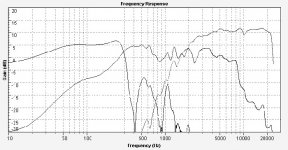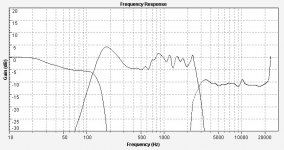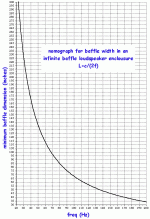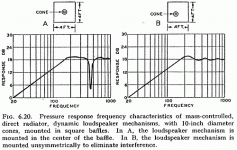Yes, the baffle has to be rather stiff. The W-baffle was first made of 18mm plywood, but as you can imagine this was not enough. The woofers are firing staight at the baffle at a very close range. I added some damping panels to the sides of 4mm bitumen and added another wood panel of 9mm to it. Now the sides are very quiet.
The W-baffle is also open at the back indeed, as you mentioned it's something like a folded bigger baffle. You would get the same results by building a large baffle of 120*160 cm to get the same path lenght between front and back.
There is one big drawback in using a w-baffle (or H-baffle) and that's the cavity resonances. Because of this my wooferrs are only usable up till 120Hz, with 48dB/oct crossover. With 24dB/oct crossover I wouldn't use them up till 100Hz at maximum.
The plexiglass baffle isn't completely on the picture because ther is another tweeter in it above the midrange. I don't use that tweeter anymore, that was just a experiment to see what it would do with a dipole tweeter. The size of the baffle is 40*60cm and hangs on the seeling. The tape you see on it on the picture was just to get them in the right angle (have to drill some more holes in the ceiling). The plexiglas is very stiff and acoustically dead, no worries about that.
Be aware that you cannot just put a speaker in a small baffle like that. The size was choosen from a lot of experimantal baffle's. the small one did have the best off-axis response but you need to compensate the early roll-off and the output peak at 500Hz, this requires active filtering. There is no way you can do this passive. If you want to go the passive way you just have to build something much bigger than this. It took me a long time and a lot of experiments to find out that mr. Linkwitz was wright al along, it's all on his website, have a good look at the Phoenix design and specially at the crossover design for it, it explains all you need to know.
I'm going to build another baffle soon wich hold the midrange and the horntweeter. But first I'm gonna try some other tweeters again. Have tried many, many tweeters and the quest for the best tweeter still continues, although the ribbon/horn was the best sofar (and strangly enough also the cheapest) I still have the feeling things can be better.
I have added a picture of the measured frequency response and one off the freq response of the active crossover I have made for it.
The W-baffle is also open at the back indeed, as you mentioned it's something like a folded bigger baffle. You would get the same results by building a large baffle of 120*160 cm to get the same path lenght between front and back.
There is one big drawback in using a w-baffle (or H-baffle) and that's the cavity resonances. Because of this my wooferrs are only usable up till 120Hz, with 48dB/oct crossover. With 24dB/oct crossover I wouldn't use them up till 100Hz at maximum.
The plexiglass baffle isn't completely on the picture because ther is another tweeter in it above the midrange. I don't use that tweeter anymore, that was just a experiment to see what it would do with a dipole tweeter. The size of the baffle is 40*60cm and hangs on the seeling. The tape you see on it on the picture was just to get them in the right angle (have to drill some more holes in the ceiling). The plexiglas is very stiff and acoustically dead, no worries about that.
Be aware that you cannot just put a speaker in a small baffle like that. The size was choosen from a lot of experimantal baffle's. the small one did have the best off-axis response but you need to compensate the early roll-off and the output peak at 500Hz, this requires active filtering. There is no way you can do this passive. If you want to go the passive way you just have to build something much bigger than this. It took me a long time and a lot of experiments to find out that mr. Linkwitz was wright al along, it's all on his website, have a good look at the Phoenix design and specially at the crossover design for it, it explains all you need to know.
I'm going to build another baffle soon wich hold the midrange and the horntweeter. But first I'm gonna try some other tweeters again. Have tried many, many tweeters and the quest for the best tweeter still continues, although the ribbon/horn was the best sofar (and strangly enough also the cheapest) I still have the feeling things can be better.
I have added a picture of the measured frequency response and one off the freq response of the active crossover I have made for it.
Attachments
Size does matter
Hmm... seems that women are right - Size does matter
The sound of OB's have given me the interest in this type of speaker, but the size is going to cause nasty interference with the SpouseAcceptanceFactor! ( == Problem )
)
Would it be possible to make a dipole mid/treble, with correspondingly smaller baffle, and an "ordinary" sub, or would it really mess up the sound to mix these two concepts, making it worse than an all-boxed design?
Jennice
Hmm... seems that women are right - Size does matter
The sound of OB's have given me the interest in this type of speaker, but the size is going to cause nasty interference with the SpouseAcceptanceFactor! ( == Problem
 )
)Would it be possible to make a dipole mid/treble, with correspondingly smaller baffle, and an "ordinary" sub, or would it really mess up the sound to mix these two concepts, making it worse than an all-boxed design?
Jennice
Yes, you can dipole the mid and treble, but the theory of the dipoles is to ged rid of the room resonances (among others), that are related to the room sizes, that ocurs not at 1500Hz, but at much lower frequencies, 300Hz and below.
Hence, you loose too much of the good point. However, you will have a resonce free box.
Hence, you loose too much of the good point. However, you will have a resonce free box.
johninCR said:Here's a graph for baffle width vs frequency of rolloff.
http://www.angelfire.com/electronic/DIY/OB-Speaker-concept-1b.html
There are 3 or 4 different of these floating around, including one i made based on Olsen. It seems that the most accurate results flow out of Linkwitzes work and, IIRC, this boils down in its simplest form to 0.17 x f(bafflewidth) for the roll-off point.
dave
johninCR said:Before I get too tangled up in the math, do you mean the equation f= .17 * v/D ?
where:
f = roll off point (where output = sealed box)
v = 343 meters/sec (speed of sound)
D = Baffle radius for circular baffle
f would be the f3 point for the dipole cancelation ignoring the driver's Q... ie assuming it is flat to well below the baffle cutoff.
dave
Dave,
I don't mean to be hardheaded. On Linkwitz's site I found the equation f= .17 * v/D
where:
f = roll off point (where output = sealed box)
v = 343 meters/sec (speed of sound)
D = Baffle radius for circular baffle
Are you saying that f is actually the f3 point, so the rolloff starts half an octave higher? His formula is already telling me that a 1 meter diameter baffle gets me flat only to 117hz which seems pretty high. Do I have the wrong formula or something? Please clarify this for me, as a simple starting point formula would be nice to have.
I don't mean to be hardheaded. On Linkwitz's site I found the equation f= .17 * v/D
where:
f = roll off point (where output = sealed box)
v = 343 meters/sec (speed of sound)
D = Baffle radius for circular baffle
Are you saying that f is actually the f3 point, so the rolloff starts half an octave higher? His formula is already telling me that a 1 meter diameter baffle gets me flat only to 117hz which seems pretty high. Do I have the wrong formula or something? Please clarify this for me, as a simple starting point formula would be nice to have.
johninCR said:I don't mean to be hardheaded. On Linkwitz's site I found the equation f= .17 * v/D
where:
f = roll off point (where output = sealed box)
v = 343 meters/sec (speed of sound)
D = Baffle radius for circular baffle
Are you saying that f is actually the f3 point, so the rolloff starts half an octave higher? His formula is already telling me that a 1 meter diameter baffle gets me flat only to 117hz which seems pretty high. Do I have the wrong formula or something? Please clarify this for me, as a simple starting point formula would be nice to have.
The only points usually discussed are where the response is down 3 dB... i have no idea where the sealed box even comes into the picture. There was quite a long discussion here on the forum, and the 0.17 figure of merit seemed to best correspond with measured data (i actually plotted some data provided). A 1 m wide baffle should get you to 58 Hz.
This is way better than the 170 Hz or so that Olsen predicts (see attached chart)
dave
Attachments
IIRC the Figure of merit is for Fequal.The only points usually discussed are where the response is down 3 dB... i have no idea where the sealed box even comes into the picture.
Linkwitz H baffle
Since the frequency responce is for ideal drivers, IMHO 3 db is noise.Output equal to a closed box occurs at Fequal = 0.17*v/D = 117 Hz with the 20" path difference D between the positive and negative polarity sources at the H baffle openings.
HTH
Doug
I like that 58hz for a 1m baffle much more, which makes the D in Mr. Linkwitz's formula Diameter not Distance of radius. I've been listening to a pair of 15" selenium coaxials with no baffle, while I plan one for them. I thought after listening to some tone sweeps that I was getting down to about 150 before rolloff started.
This discussion made me get out the SPL meter and check it. Sure enough it starts at just over 300 like the formula with D for radius predicted for a 15" diameter baffle. That scared me into thinking that really big baffles were needed, until I thought about it and realized that would apply if the sound was originating from the center of cone, but it's not, it's out on the cone.
So Dave, the bottom line is that the formula f = .17 * v/D
where:
f = roll off point
v = 343 meters/sec (speed of sound)
D = Baffle width
is a good reference point, correct ?
This discussion made me get out the SPL meter and check it. Sure enough it starts at just over 300 like the formula with D for radius predicted for a 15" diameter baffle. That scared me into thinking that really big baffles were needed, until I thought about it and realized that would apply if the sound was originating from the center of cone, but it's not, it's out on the cone.
So Dave, the bottom line is that the formula f = .17 * v/D
where:
f = roll off point
v = 343 meters/sec (speed of sound)
D = Baffle width
is a good reference point, correct ?
Variac said:well, I have a theory too!!!
I think some of the formulas and charts are for baffles with one side on the floor OR on top of another cabinet, which is in effect, the same thing as being on the floor. So one side is an infinite baffle.
That makes sense, but I believe the roll off due to cancellation must start to occur based on the shortest distance to the edge and increase in slope until all of the edges are reached. Does that mean with a fairly wide baffle sitting on the floor the maximum slope of the rolloff would be more like 5db/octave?
John-
I think an edge quite a bit further from the driver than the formula calculates, can compensate for an edge that is closer than calculated , and if the "average" size is as much as the calculation, then no roll off of the driver response except the "natural" roll off of about 6db that drivers inherently have. (until the calculated freq )
)
From being in lots of these discussions, I think I can confirm that
all the sound doesn't "short circuit" around the shortest baffle dimension. So, even if there is a short edge, it can be compensated for by a farther away one.
So, even if there is a short edge, it can be compensated for by a farther away one.
I guess the test is a baffle with half the area long "petals" and half the area very short. The baffle should look like a flower with say...., 8 petals. My statement says the roll off point is the average of the 2 lengths, I think yours says that there might be an inefficiency from the relatively narrow petals. BUT the slots between the petals are then also narrow!

OK also to sum up- the frequency response matches the slope of the driver until it gets down to Fs. If the baffle is smaller than required by the Fs , then the slope increases in steepness (downward by 6dB) until the Fs is reached when things likely will fall off precipitously.
by 6dB) until the Fs is reached when things likely will fall off precipitously.
Also, something I had forgotten- NO ROOM GAIN
OK Is this pretty much right eveyone?
Oh yeah- also- a driver that isn't not in the center of a baffle will almost invariably have smoother response than a centered one.
I think an edge quite a bit further from the driver than the formula calculates, can compensate for an edge that is closer than calculated , and if the "average" size is as much as the calculation, then no roll off of the driver response except the "natural" roll off of about 6db that drivers inherently have. (until the calculated freq
From being in lots of these discussions, I think I can confirm that
all the sound doesn't "short circuit" around the shortest baffle dimension.
I guess the test is a baffle with half the area long "petals" and half the area very short. The baffle should look like a flower with say...., 8 petals. My statement says the roll off point is the average of the 2 lengths, I think yours says that there might be an inefficiency from the relatively narrow petals. BUT the slots between the petals are then also narrow!


OK also to sum up- the frequency response matches the slope of the driver until it gets down to Fs. If the baffle is smaller than required by the Fs , then the slope increases in steepness (downward
Also, something I had forgotten- NO ROOM GAIN
OK Is this pretty much right eveyone?
Oh yeah- also- a driver that isn't not in the center of a baffle will almost invariably have smoother response than a centered one.
Originally posted by Variac Oh yeah- also- a driver that isn't not in the center of a baffle will almost invariably have smoother response than a centered one.
generally.
dave
Attachments
Variac said:
Also, something I had forgotten- NO ROOM GAIN
I was thinking about that the other day. Too bad because it sure would make things easier if we had room gain along with dipole sound.
Regarding your short side/long side and flower petal ideas. Cancellation has to start where the waves begin to meet at the short edge. The long side doesn't give you boost to offset the cancellation that must be occuring on the short side, it just gives lower extension to where it becomes the full 6db rolloff. So the net result is a shallower slope. I do, however, believe that some cancellation resulting from one somewhat short side is not likely to have an appreciable effect on response.
I've read enough to know not to have the drivers centered, and I think I even have a handle on why, but thanks for the advice anyway.
Well John, First of all I wouldn't think of giving you advice, considering all the real world experimentation you are doing.
I was just summing up my understanding of the situatuation and seing if others agreed I was generally on track.
Well, thinking of it as boost might be confusing. Let's say that the cut off frequency desired is 50hz. So let's also say that half the baffle is too short for 50 hz say it's 60hz. BUT the long side is LONGER than necessary for 50 hz -say it's 40 hz. So you average the 2 halves and end up with a 50hz cut off overall.
The point is that the "long" side needs to be longer than the average baffle size and balances out the "short" side which is shorter than the average baffle size. My suspician is that a "flower" type baffle with the proportions as just described would work fine. As would a baffle that is entirely a circle exactly the calculated size. I really don't know for sure though.
Now when a baffle side is on the ground or on a panel or box that goes to the ground this forms the "infinite baffle"
NO sound sneaks around this side, so it acts like a "long side" longer than the lowest frequencies that you are reproducing.
When this gets averaged into the mix of long and short sides, suddenly the baffle can be a LOT smaller.
OK, I find it hard to complain about the physics of room gain not helping us now that we have found out that baffles really don't have to be as big as we thought
PLUS I wonder: if the driver/port is right next to the floor do we pick up some boundary gain at least? (won't work for coax's obviously)
I was just summing up my understanding of the situatuation and seing if others agreed I was generally on track.
The long side doesn't give you boost to offset the cancellation
Well, thinking of it as boost might be confusing. Let's say that the cut off frequency desired is 50hz. So let's also say that half the baffle is too short for 50 hz say it's 60hz. BUT the long side is LONGER than necessary for 50 hz -say it's 40 hz. So you average the 2 halves and end up with a 50hz cut off overall.
The point is that the "long" side needs to be longer than the average baffle size and balances out the "short" side which is shorter than the average baffle size. My suspician is that a "flower" type baffle with the proportions as just described would work fine. As would a baffle that is entirely a circle exactly the calculated size. I really don't know for sure though.
Now when a baffle side is on the ground or on a panel or box that goes to the ground this forms the "infinite baffle"
NO sound sneaks around this side, so it acts like a "long side" longer than the lowest frequencies that you are reproducing.
When this gets averaged into the mix of long and short sides, suddenly the baffle can be a LOT smaller.
OK, I find it hard to complain about the physics of room gain not helping us now that we have found out that baffles really don't have to be as big as we thought
PLUS I wonder: if the driver/port is right next to the floor do we pick up some boundary gain at least? (won't work for coax's obviously)
Konnichiwa,
I think most here still misunderstand dipoles on many fundamental levels.
1) Room (gain) interactions
A dipole will interact in many ways with room boundaries just like any other speaker, EXCEPT the output towards the rear is opposite polarity. This means the attenuation is the same as common, but the disps and peaks from cancellation/reinforcement fall at different frequencies.
When placed on the floor with the baffle sufficiently airtight to the floor the "floor image" of baffle & driver will add to both front and rear radiation in the same way it does for conventional speakers. If this woprks right than at low frequencies a nearly 6db increase in SPL can be observed.
2) Baffle rolloff frequency
Soundwaves are spherical. For a baffle in a lot of ways the relevant parameter is the surface area, not the width. Of course, for extreme constructs (very narrow and very tall) this no longer holds quite true.
The net effect is that AS LONG AS YOUR DRIVER REMAINS FLAT IN RESPONSE (eg. Qt =0.7 with flat LF to MF response - a Qt above 0.7 can compensate some baffle rolloff) a baffle with much smaller dimensions as suggested in many older references suffices.
Of course, such drivers as I describe practically do not exist, most drivers available have a Qt << 0.7 and hence will NEVER EVER give a flat response, not even on a true INFINITE baffle.
Sayonara
I think most here still misunderstand dipoles on many fundamental levels.
1) Room (gain) interactions
A dipole will interact in many ways with room boundaries just like any other speaker, EXCEPT the output towards the rear is opposite polarity. This means the attenuation is the same as common, but the disps and peaks from cancellation/reinforcement fall at different frequencies.
When placed on the floor with the baffle sufficiently airtight to the floor the "floor image" of baffle & driver will add to both front and rear radiation in the same way it does for conventional speakers. If this woprks right than at low frequencies a nearly 6db increase in SPL can be observed.
2) Baffle rolloff frequency
Soundwaves are spherical. For a baffle in a lot of ways the relevant parameter is the surface area, not the width. Of course, for extreme constructs (very narrow and very tall) this no longer holds quite true.
The net effect is that AS LONG AS YOUR DRIVER REMAINS FLAT IN RESPONSE (eg. Qt =0.7 with flat LF to MF response - a Qt above 0.7 can compensate some baffle rolloff) a baffle with much smaller dimensions as suggested in many older references suffices.
Of course, such drivers as I describe practically do not exist, most drivers available have a Qt << 0.7 and hence will NEVER EVER give a flat response, not even on a true INFINITE baffle.
Sayonara
- Status
- This old topic is closed. If you want to reopen this topic, contact a moderator using the "Report Post" button.
- Home
- Loudspeakers
- Multi-Way
- Open baffles for dummies ;)



